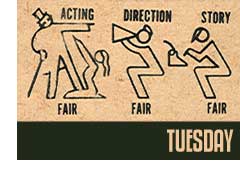
There’s nothing like having the contractors show up first thing Monday morning to fill you with confidence. Not that I would know. It’s a busy day, and besides, what could I possibly have to say? I’ve been sitting at the kitchen counter writing or not writing all morning and afternoon, and that cuts down on the exciting thrills ‘n’ spills accounts of running to the mall and hyperparsing their customer service strategies. (It’s interesting how many emails I get from people who don’t understand that I am slightly exaggerating for the purpose of having fun with You, the Reader.) Luckily, it’s Noir season around here, since I just got a batch of new old movies. My favorite kind. It’s that sequel to the rollickin’ fun loving musical, "The Brightly Lit Middle of the Room:"
Based on a story from Good Housekeeping, according to the trailer. The Bad Guy:
Hello Dear, it’s your rich effete husband whose withering cruelty masks the fact that he not only is insanely possessive of you, he really has no sex drive to speak of, merely a desire to glide around in a tux and issue bitchy remarks about younger, better looking people, all of whom are secretly laughing at his dryer-lint eyebrows. I’m home! What’s for supper? DEATH? Your hero:
It’s Mark Stevens, zoomer, as “Bradford Galt,” private dick. You suspect that Mr. Stevens career path was not entirely known to all, since they had to remind everyone he had recently attained the firmament of starhood. He would die in Spain in 1994; his penultimate acting appearance was on Magnum PI. Jessica Simpson would later inherit his chin in a complex legal battle. The dame:
Apparently she loathed every moment of this movie, but you can’t tell. Not a screwball note in her performance; she’s a dutiful gal-Friday secretary. Odd how people in my generation never really thought of her as a looker. She was just Lucy. She had presence in this movie, but no smolder. She was a sparkler, and they don't have fuses. The bad guy, shown here at his meanest EVER, was William Bendix.
Bendix was a grocer who went into movies after the Depression K-O’d his store. He’s just killed a man here, and as you can see, remorse is not uppermost among his emotions. In fact he’s rubbing the thumb the hero had busted earlier, and it spurs him on to an act of additional sadism. Look at that lighting: it highlights the hand, half the face, the door, and the window beyond. The scene takes 10 seconds, maybe 20, but the composition and effect lasts well beyond. This is why I love noir:
An early shot in the film. Even the simplest of moments – a man walking up the stairs – is fraught with foreboding and drama, thanks to the limitations of the medium. Of course, it was a conscious decision to be limited; they had color. But color was more real than life itself, sometimes; this was the heart of the city, stripped of paint. As the man moves up the stairs he drops in and out of the light, and the folds of his garment writhe like the leathery skin of some nasty canny reptile. Sometimes, of course, the conventions of the genre are on display with more force than necessary:
Slantwise Venetian blinds! No self-respecting shamus hung anything less in his room. Again, check the lighting and the depth of the scene. No accident: the hero, who's in all sorts of bad trouble, occupies the space closest to us. Lucy, his assitant and moral compass, is in the middle; out the window, the World Beyond. We'll see this idea again. On the other hand: the genre can go minimal, with brilliant results:
Then the door open and the light floods in.
That’s what makes noir. That, and the fact that he has two bottles on his desk. The final shot, after law and morality and the order of the universe has been restored:
In the background, the victorious couple, off to get married, heading through the door to the world that exists outside the movie; in the middle, the policeman, guardian of Order. in the foreground, an abstract statue, shrouded and unnatural, symbolic of the values of the art collector who set the disorder in motion. It’s not that great a movie. Much better is something I saw two weeks ago, which had fewer scenes to grab but much, much better direction. And the commentary track – which I usually never listen to – is just terrific; it’s by Eddie Muller, a noir historian and novelist, and he makes an immediate second viewing worth your time. It’s called “Where the Sidewalk Ends.” Buy or rent, if you want some neat crisp noir. And why wouldn’t you? New Quirk and new Motels; see you tomorrow.
|
|||||||||||||||||||||||||||||||
| c. j. lileks 2006. Email may be sent to first name at last name dot com. |













